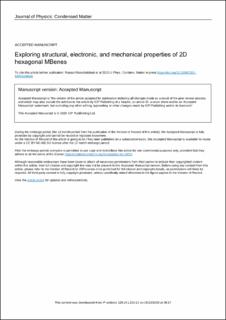| dc.description.abstract | A family of two-dimensional (2D) transition metal borides, referred to as MBenes, is recently emerging as novel materials with great potentials in electronic and energy harvesting applications to the field of materials science and technology. MBenes can be synthesized from chemical exfoliation of ternary-layered transition metal borides, known as MAB phases. Previously it has been predicted that thin pristine 2D Sc-, Ti-, Zr-, Hf-, V-, Nb-, Ta-, Mo-, and W-based MBenes with hexagonal phase are more stable than their corresponding orthorhombic phase. Here, using a set of first-principles calculations we have examined the geometric, dynamic stability, electronic structures, work function, bond strength, and mechanical properties of the hexagonal monolayer of MB MBenes (M = Sc, Ti, Zr, Hf, V, Nb, Ta, Mo, and W) chemically terminated with F, O, and OH. The results of the formation energies of terminated MBenes imply that the surface terminations could make a strong bond to the surface transition metals and provide the possibility of the development of MBenes with those surface terminations. Except for ScBO, which is an indirect bandgap semiconductor, the other MBenes are metallic or semimetal. Particularly, TiBF, ZrBF, and HfBF are metallic systems whose band dispersions close to the Fermi level indicate the coexistence of type-I and type-II nodal lines. Our calculated work functions indicate that 2D MBs with OH (O) functionalization obtain the lowest (highest) work functions. The results of the mechanical properties of the considered MBenes imply that oxygen functionalized MBenes exhibit the stiffest mechanical strength with 248 < E (N/m) < 348 while non-terminated MBenes are generally the weakest systems with 206 < E (N/m) < 283. | en_US |

